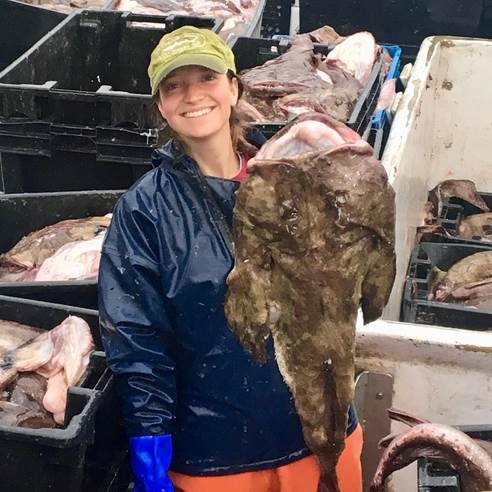Monkfish may look like horrific sea monsters, but can Mainers look past that enough to place the fish center stage on the dinner table?
The Maine Coast Fishermen’s Association hopes so. The nonprofit, in partnership with Luke’s Lobster, plans a series of meals and demonstrations to shine a spotlight on underappreciated fish species that could diversify and strengthen Maine’s fishing industry.
First up in the What’s the Catch? series is monkfish, a species that had its heyday about two decades ago but has since fallen out of popularity. A ticketed event on Jan. 8 at Luke’s Lobster on the Portland waterfront will include tasting monkfish prepared several ways and a fish-cutting demonstration.
The fish, also called goosefish or angler fish, are commonly known to be truly ugly, with enormous mouths filled with sharp teeth, brownish color and an oblong tadpole-shaped body. Adult fish can grow to be 3 feet to 4 feet long, but the tail meat is one of the only marketable parts.
Despite its appearance, monkfish tastes really good and can be prepared easily in all sorts of ways, said Zac Leeman, head chef at Luke’s in Portland. He plans to showcase fried monkfish nuggets, pan-roasted fish with chili butter, and a fish stew. At home, it can be fried, broiled, poached, sautéd and grilled.
“It really is a beautiful fish once you cook it, and it is very, very versatile, it has a flavor that holds so you don’t have to worry about masking it, you can wrap it in bacon, it goes with Mediterranean and Asian flavors,” Leeman said. “It is very, very tender, it is a delicious fish and I think more people should know about it.”
The monkfish fishery was booming about two decades ago, but overfishing concerns prompted catch limits in 1999 and shrinking local demand. Fishermen landed 400 tons of monkfish in Maine last year, just 6 percent of the peak landings in 2003. The total catch was worth almost $674,300, roughly 71 cents a pound.
“There is still demand for it, I just think it has dropped off and we don’t want people to forget about it,” Leeman said.
As Maine’s fishing industry has shifted to a reliance on lobster, consumers pay less attention to local, sustainable fish species still being brought in by the state’s dwindling fishing fleet. In the 1990s, close to 300 boats took at least one groundfishing trip a year, said Ben Martens, executive director of the Maine Coast Fishermen’s Association. These days, just over 50 boats a year made at least one trip.
Even though there are fewer boats, they are still bringing in fish, but to boost prices for lesser-known species like monkfish, flounder, hake and pollock requires consumer education and outreach.
“To be really blunt, the price has been bad for our fishermen,” Martens said. “When you have this great product that fishermen aren’t getting paid for that the local consumers don’t know about, there is an opportunity to do something really cool to change that.”
Part of the strategy to highlight lesser-known Maine fish is to introduce consumers to fishermen, too, Martens added. Forming connections between seafood lovers and the people who bring in the catch is important to preserving Maine’s working waterfront as it faces increased development and tourism threats.
“We’re trying to remind the city of Portland and Maine that fishermen are part of the food system and what makes Maine unique,” Martens said. “Monkfish is never going to replace lobster in Maine, it is not going to replace groundfish, but it can be an important piece of the mosaic of the catch that comes across the docks.”
Monkfish stocks have stabilized since the management plan was enacted 20 years ago. The fish can be caught from the Gulf of Maine to Cape Hatteras in North Carolina. In the management area north of Georges Bank, fishermen catch monkfish on trips for other species, but the southern management area has a fishery that targets them specifically.
Last year, fishermen in the northern area landed 6,168 metric tons, just below the catch limit. The southern area landed 4,600 tons, only 50 percent of the limit, according to a draft 2019 operational assessment from the fisheries section of the National Oceanic and Atmospheric Administration.
Stocks are stable enough that regulators at the New England Fishery Management Council recommended a 10 percent increase in annual catch limits until 2022.
“It is not like the stock is in a dire condition, it is doing well enough that the council was OK with an increased limit,” said Janice Plant, the council’s public affairs officer. “It is definitely a valid alternative, it is a healthy resource and monkfish taste good,” she added.
The Monterey Bay Aquarium Seafood Watch program grades monkfish as a good alternative, one grade below best choice. Monkfish are not being overfished and management is moderately effective, but its bycatch can include at-risk species such as Atlantic cod, some flounders and Atlantic sturgeon, according to Seafood Watch.
Luke’s plans to have special monkfish items on its menu for the rest of January. What’s the Catch will highlight a different fish species in a similar format on the first Wednesday of every month until April, said Merritt Carey, community relations manager at Luke’s Lobster.
There is limited seating for the event and tickets are $55, including a specialty cocktail.
“We got involved because we are always trying to highlight the other fisheries that are right here in Maine that a lot of people don’t know about,” Carey said.
“Obviously lobster takes center stage, but there are really incredible underutilized species. The more we can shine a light on those and make consumers aware of them, the better it is for our entire coastal economy.”
Comments are not available on this story.
Send questions/comments to the editors.



